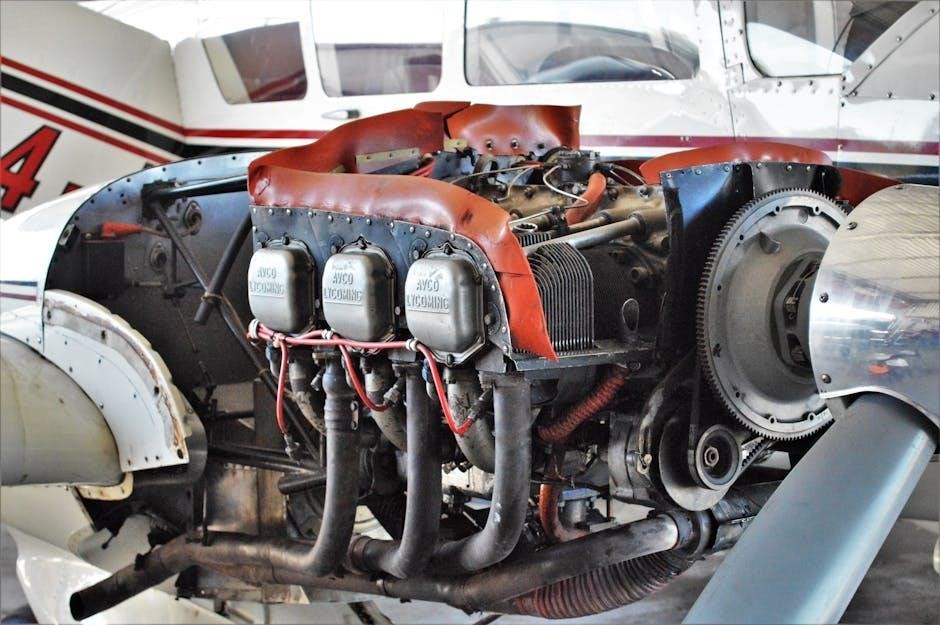This manual provides comprehensive guidance for servicing, maintaining, and overhauling Perkins 4-cylinder diesel engines, ensuring optimal performance and longevity. It covers essential procedures, safety protocols, and technical specifications.

Key Features and Specifications of the Perkins 4-Cylinder Diesel Engine
The Perkins 4-cylinder diesel engine offers a robust, naturally aspirated design, ideal for agricultural and industrial applications, delivering reliable power, efficient fuel consumption, and emissions compliance.
2.1. Engine Overview and Applications
The Perkins 4-cylinder diesel engine is a robust, naturally aspirated power unit designed for reliability and efficiency in demanding environments. Ideal for agricultural and industrial applications, it powers tractors, generators, and machinery with consistent performance. Its durable construction and fuel-efficient design make it a preferred choice for operators seeking a balance of power and economy. This engine is well-suited for heavy-duty tasks, ensuring minimal downtime and optimal productivity in various operational settings.
2.2. Technical Specifications and Performance Data
The Perkins 4-cylinder diesel engine features a displacement of 2.7 liters and delivers up to 60 horsepower at 3,000 RPM. It offers a maximum torque of 170 Nm at 1,800 RPM, ensuring strong pulling power. The engine is equipped with a mechanical fuel injection system and operates efficiently within a wide range of applications. Its compact design and lightweight structure make it ideal for various industrial and agricultural uses, providing a reliable power source with minimal fuel consumption and reduced emissions.
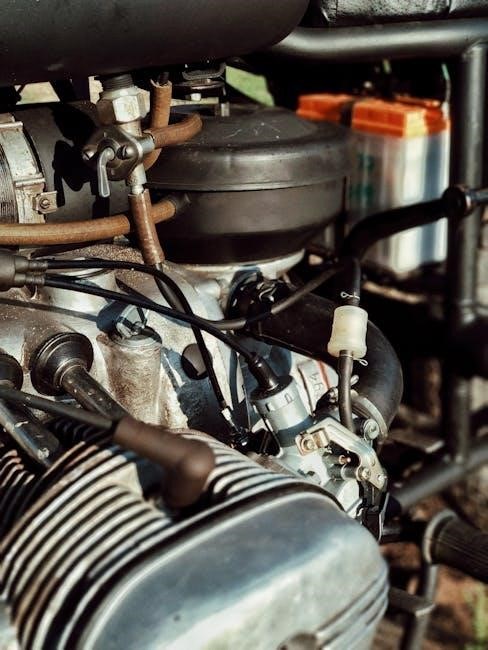
Structure and Content of the Manual
The manual is divided into sections covering engine overview, technical specifications, maintenance schedules, and repair procedures. It includes detailed diagrams, troubleshooting guides, and essential safety protocols for optimal performance and longevity.
3.1. Sections Covered in the Manual
The manual includes sections on engine overview, technical specifications, maintenance schedules, and repair procedures. It covers disassembly, inspection, and reassembly processes, along with troubleshooting guides and safety protocols. Additional sections detail fuel system maintenance, cooling system service, and electrical component checks. The manual also provides torque specifications, diagnostic techniques, and error code interpretations. Detailed diagrams and step-by-step instructions ensure clarity for technicians and operators, making it an essential resource for optimal engine performance and longevity.
3.2. Importance of Following the Manual Guidelines
Following the manual guidelines ensures proper engine maintenance, safety, and compliance with manufacturer standards. Adhering to the instructions helps prevent costly repairs, extends engine longevity, and maintains optimal performance. The manual provides critical information on torque specifications, diagnostic techniques, and safety protocols. Ignoring these guidelines can lead to premature wear, potential accidents, or voiding warranties. By following the manual, users can ensure their Perkins 4-cylinder diesel engine operates efficiently and reliably, meeting intended specifications and industry standards for years of reliable service.

Technical Specifications of the Perkins 4-Cylinder Engine
The Perkins 4-cylinder diesel engine offers a horsepower range of 60-150 HP, with torque up to 400 Nm. It features a 4.0L displacement, direct fuel injection, and meets emissions standards.
4.1. Engine Dimensions and Weight
The Perkins 4-cylinder diesel engine measures approximately 1,200mm in length, 700mm in width, and 1,000mm in height. It weighs around 500-600 kg, depending on the model and configuration. These dimensions make it suitable for various industrial and marine applications. The compact design ensures efficient installation in limited spaces while maintaining durability. Weight variations occur due to differences in cooling systems, exhaust configurations, and additional components. Always refer to the specific model manual for precise measurements to ensure proper installation and handling.
4.2. Fuel System and Consumption
The Perkins 4-cylinder diesel engine features a robust fuel system designed for efficient performance. It includes components like fuel pumps, injectors, and filters, ensuring precise fuel delivery. Fuel consumption rates vary based on load and application, typically ranging from 8-12 liters per hour. Proper maintenance, such as regular filter replacements, is crucial for optimal efficiency. The manual provides detailed guidelines for fuel system servicing and troubleshooting to minimize consumption and maximize engine performance. Adhering to these recommendations ensures reliable operation and extends engine lifespan.
4.3. Emissions and Compliance Standards
The Perkins 4-cylinder diesel engine is designed to meet stringent emissions standards, ensuring environmental compliance. It adheres to regulations such as UN ECE R96 Stage IIIA or below, incorporating advanced technologies to reduce emissions. The engine’s fuel injection system and combustion chamber design optimize performance while minimizing exhaust pollutants. Regular maintenance, as outlined in the manual, is essential to maintain compliance and ensure the engine operates within specified emission limits, contributing to a cleaner environment and prolonged engine reliability.

Maintenance Schedule and Service Intervals
Regular maintenance is crucial for optimal performance. Routine tasks include oil and filter changes, belt inspections, and coolant checks; Service intervals vary based on usage and conditions.
5.1. Routine Maintenance Tasks
Routine maintenance is essential for ensuring the Perkins 4-cylinder diesel engine operates efficiently and reliably. Key tasks include oil and filter changes, fuel filter inspections, and coolant level checks. Air filter cleaning or replacement should also be performed regularly. Additionally, inspecting belts for wear and tensioning them as needed is crucial. Checking for any signs of leaks or wear on hoses and connections is recommended. Always consult the manual for specific service intervals to avoid premature wear and potential engine issues.
5.2. Oil and Filter Change Procedures
Regular oil and filter changes are vital for maintaining the Perkins 4-cylinder diesel engine. Begin by warming the engine and locating the drain plug. Use a suitable container to collect the old oil. Replace the oil filter with a new one, ensuring it is properly seated. Refer to the manual for the correct torque specification. Fill the engine with the recommended oil grade. Dispose of used oil and filters responsibly. Always follow the manual’s guidelines for service intervals to ensure optimal engine performance and longevity.
5;3. Belt Replacement and Tensioning
Inspect serpentine and auxiliary belts for cracks, wear, or misalignment. Replace belts showing signs of damage. Use a belt tension gauge to ensure proper tension, adhering to specifications in the manual. Loosen the tensioner pulley, remove the old belt, and install the new one. Tighten the tensioner and check alignment. For multiple belts, follow the same procedure. Refer to the manual for torque specifications and replacement intervals. Proper tensioning prevents engine overheating and ensures reliable operation. Always dispose of old belts responsibly.
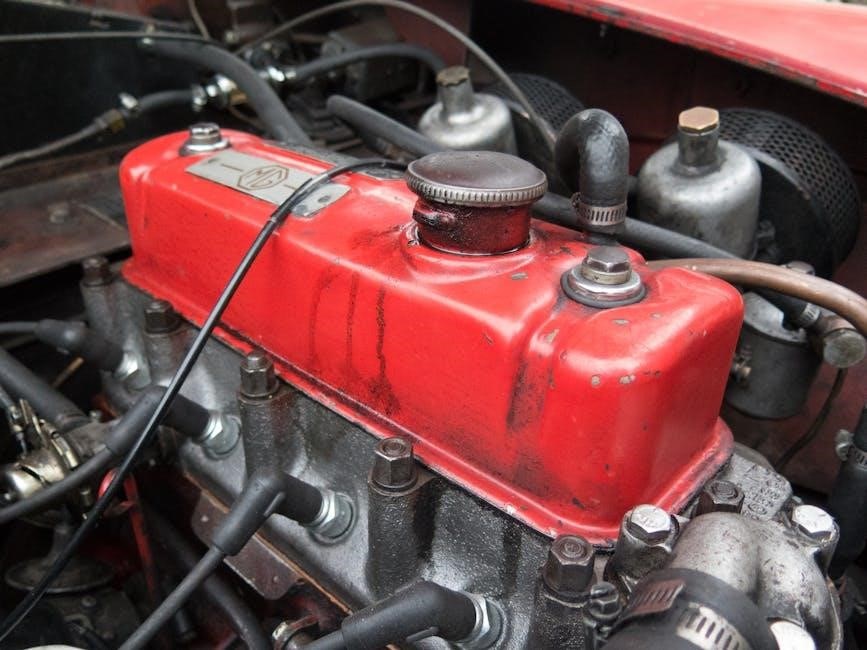
Overhaul and Repair Procedures
This section outlines detailed steps for disassembling, inspecting, and reassembling the engine. It includes procedures for replacing worn components and troubleshooting common issues, ensuring proper restoration of engine functionality and performance. Follow the manual’s guidelines for torque specifications and reassembly to maintain engine integrity and reliability. Proper tools and techniques are essential for a successful overhaul, as outlined in the manual. Always refer to the Perkins 4-cylinder diesel engine manual for specific instructions and safety precautions to avoid damage or injury. Adherence to the manual ensures optimal engine operation post-repair.
6.1. Engine Disassembly and Inspection
Disassembling the Perkins 4-cylinder diesel engine requires careful preparation and adherence to the manual’s guidelines. Start by draining fluids and disconnecting external components. Remove the cylinder head, timing gear, and other major parts systematically. Document each step and label components for reassembly. Inspect all parts for wear, damage, or corrosion. Check cylinder walls, piston rings, and bearings for excessive wear. Refer to the manual for torque specifications and proper tools. This process ensures a thorough evaluation of engine condition, enabling effective repairs and preventing further damage. Always follow safety protocols to avoid injury or component damage during disassembly.
6.2. Reassembly and Testing
Reassembly of the Perkins 4-cylinder diesel engine must follow the manual’s precise guidelines to ensure proper functionality. Begin with the engine block, reinstalling components like the crankshaft, pistons, and cylinder head in sequence. Tighten bolts to specified torque values using a micrometer for accurate measurements. After reassembly, perform an initial test by priming the fuel system and checking for leaks. Start the engine at low idle to observe operation and listen for unusual noises. Conduct a full test under load to verify performance and efficiency, ensuring all systems function optimally before returning the engine to service.
6.3. Common Issues and Solutions
Common issues with the Perkins 4-cylinder diesel engine include fuel system leaks, engine overheating, and low power output. For fuel leaks, inspect and replace worn injector seals or connections. Overheating can be resolved by cleaning or replacing the radiator and ensuring proper coolant circulation. Low power may indicate faulty fuel pumps or clogged filters, which should be serviced or replaced. Always refer to the manual for specific diagnostic tools and procedures to address these issues effectively and ensure reliable engine performance.
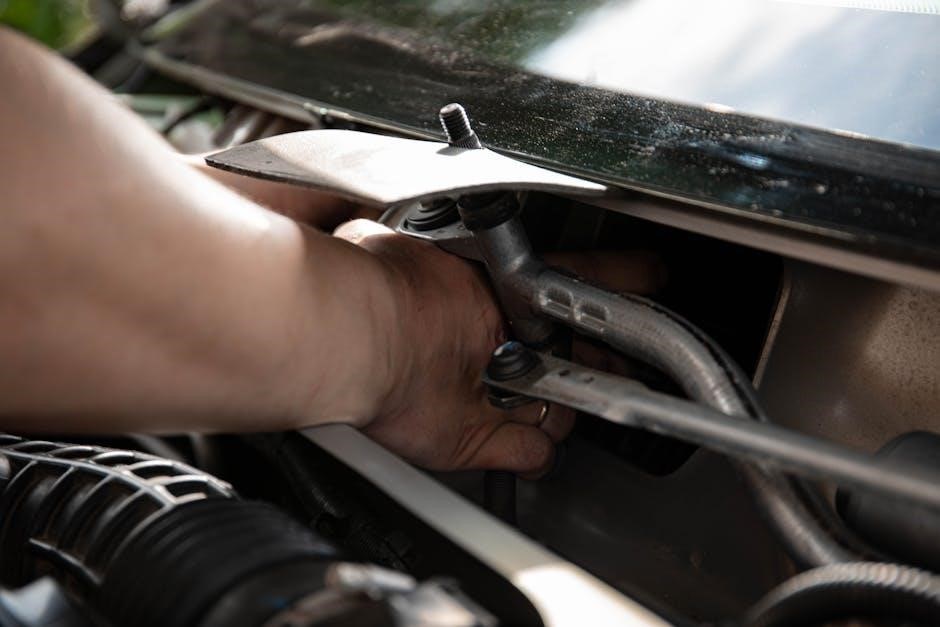
Fuel System and Injection
The Perkins 4-cylinder diesel engine features a robust fuel system designed for efficient combustion. Proper maintenance of injectors, pumps, and filters ensures optimal performance and fuel efficiency.
7.1. Fuel Pump Calibration and Adjustment
Proper calibration and adjustment of the fuel pump are critical for maintaining optimal engine performance. The process involves setting the correct fuel injection timing and pressure. Using specialized tools like a timing gauge and pressure test kit, technicians ensure precise synchronization. Improper adjustment can lead to reduced efficiency or engine damage. Always refer to the Perkins manual for specific procedures and torque specifications to guarantee accuracy and reliability during the calibration process.
7.2. Injector Maintenance and Replacement
Regular maintenance of fuel injectors is essential for ensuring proper engine performance and fuel efficiency. Inspect injectors for wear, corrosion, or clogging, and clean or replace them as needed. Replacement involves removing the old injector, installing a new one, and adjusting the fuel system to specifications. Proper sealing and alignment are crucial to prevent leaks and maintain correct fuel flow. Always use genuine Perkins parts and follow manual guidelines to ensure reliability and avoid potential engine damage from faulty injectors.
7.3. Fuel Filter Service and Upgrades
Regular servicing of the fuel filter is essential to prevent contamination and ensure optimal engine performance. Inspect and replace the filter at recommended intervals to avoid clogging and fuel flow issues. Use genuine Perkins parts to maintain reliability. Upgrading to high-performance filters can enhance fuel efficiency and engine lifespan. Always follow manual guidelines for installation to prevent damage or leaks. Proper maintenance ensures clean fuel delivery, reducing wear on injectors and engine components. Consult the manual or a Perkins specialist for upgrade options tailored to your engine needs.

Cooling System and Temperature Management
The cooling system is crucial for maintaining optimal engine temperature. It includes the radiator, hoses, water pump, and coolant. Regular maintenance ensures efficient heat dissipation, preventing overheating and damage.
8.1. Radiator and Hose Maintenance
Regular inspection of the radiator and hoses is essential to ensure proper cooling system function. Check for leaks, corrosion, and blockages in the radiator core and fins. Clean or replace the radiator as needed to maintain airflow and heat dissipation. Hoses should be inspected for cracks, brittleness, and signs of wear. Replace any damaged hoses immediately to prevent system failure. Additionally, ensure the coolant mixture is correct and flush the system periodically as per the manual’s guidelines to avoid overheating issues and extend engine lifespan.
8.2. Water Pump Replacement and Service
Regular water pump service is vital to prevent engine overheating and ensure reliable operation. Inspect the pump for signs of wear, corrosion, or leakage. Replacement involves removing the belt, draining coolant, and disconnecting hoses. Refer to the manual for specific torque settings and installation guidelines to avoid damage. Proper alignment of pulleys and belts is crucial for smooth operation. Always use genuine Perkins parts to maintain performance and durability, ensuring the cooling system functions efficiently and prevents future issues. Regular servicing extends the lifespan of the water pump and overall engine reliability.
8.3. Coolant Specification and Flush Procedures
Use a high-quality coolant meeting Perkins specifications to protect against corrosion and overheating. A 50/50 mix of ethylene glycol and water is recommended for optimal performance. Flush the system every 2 years or as specified. Drain the coolant, flush with a recommended cleaner, and rinse thoroughly. Refill with the correct mixture and bleed the system to remove air pockets. Ensure all hoses and connections are secure to prevent leaks. Always follow safety guidelines when handling coolant and dispose of it responsibly to protect the environment and comply with regulations.

Electrical System and Components
The electrical system includes the alternator, battery, wiring, and circuit components. Regular checks ensure proper charging, starting, and operation of engine systems. Follow manual guidelines for diagnostics and repairs.
9.1. Alternator and Battery Maintenance
Regular maintenance of the alternator and battery is crucial for reliable engine operation. Inspect the alternator belt for wear and proper tension, ensuring it aligns correctly. Check the battery terminals for corrosion and clean them as needed. Verify the charging system’s voltage output to prevent overcharging or undercharging. Replace the battery if it shows signs of aging or reduced performance. Always refer to the manual for specific torque settings and safety precautions during servicing to avoid damage or injury.
9.2. Wiring and Circuit Checks
Regular checks of the wiring and circuits are essential for ensuring reliable engine operation. Inspect all wires and connections for signs of damage, wear, or corrosion. Use a multimeter to test circuit resistance and voltage, ensuring they meet the specifications outlined in the manual. Loose or corroded connections should be tightened or replaced immediately. Additionally, verify that all fuses and relays are functioning correctly. If any issues are identified, consult a qualified technician for further assistance. Following these steps helps prevent electrical failures and maintains optimal engine performance.
9.3. Starter Motor and Solenoid Service
Regular inspection and maintenance of the starter motor and solenoid are crucial for reliable engine starting. Check for worn or corroded connections and clean them thoroughly. Test the solenoid’s operation by activating the starter switch and listening for the click. If the solenoid fails to engage, replace it immediately. Inspect the starter motor brushes and commutator for wear. Measure the starter motor’s resistance to ensure it aligns with specifications. If issues persist, consult a certified technician for professional repair or replacement to prevent starting problems.
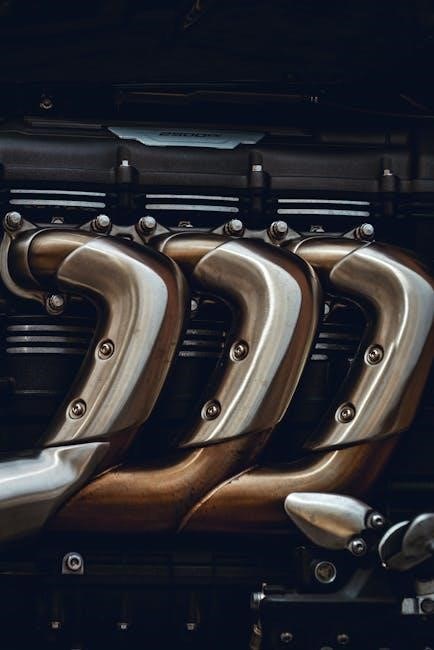
Troubleshooting Common Issues
Identify and address common issues like hard starting, low power, or excessive noise. Use diagnostic tools to detect faults and refer to error codes for solutions.
10.1. Diagnostic Techniques and Tools
Effective troubleshooting begins with advanced diagnostic techniques and tools. Utilize multimeters, compression testers, and error code readers to identify issues. Refer to the manual for specific error code meanings and solutions. Regularly check fuel pressure, injector performance, and coolant levels. Use torque specifications to ensure proper engine component tightening. Always follow safety protocols when diagnosing electrical systems. Maintain accurate records of diagnostics for future reference and preventive maintenance. Proper tool usage ensures accurate diagnoses and reliable repairs, extending engine lifespan and performance. Adhere to Perkins-recommended diagnostic procedures for optimal results.
10.2. Error Codes and Their Meanings
The Perkins 4-cylinder diesel engine manual includes a detailed list of error codes and their interpretations. These codes help identify issues such as fuel system faults, coolant temperature anomalies, or ignition problems. Common codes like “low fuel pressure” or “overheating” are explained with corrective actions. Refer to the manual’s error code section for specific meanings and troubleshooting steps. Understanding these codes enables quick diagnosis and resolution, minimizing downtime. Always consult the manual or a certified technician for unresolved issues to ensure proper repairs and maintain engine health. Regular code checks can prevent major failures.
10.3. Resetting and Reinitializing Systems
Resetting and reinitializing systems on the Perkins 4-cylinder diesel engine involves clearing fault codes and restoring default settings. Use the Perkins diagnostic tool to connect to the engine’s ECU. Follow the menu prompts to select system reset options. After repairs, reinitialize systems like fuel injection or coolant controls. Always refer to the manual for specific procedures. Improper resets can cause system instability. Consult a certified technician if unsure to ensure proper reinitialization and avoid further issues. This step is crucial for maintaining engine performance and reliability.
The Perkins 4-cylinder diesel engine manual provides essential information for optimal performance, proper maintenance, and reliable operation. Adhering to the guidelines ensures longevity and efficiency. Consult additional resources for complex repairs and troubleshooting.
11.1. Importance of Proper Maintenance
Proper maintenance is crucial for extending the life of the Perkins 4-cylinder diesel engine. Regular servicing ensures optimal performance, reduces fuel consumption, and prevents unexpected breakdowns. Adhering to the manual’s guidelines helps maintain engine efficiency and reliability. Neglecting routine tasks can lead to premature wear, costly repairs, and potential engine failure. Always follow the recommended service intervals and procedures to ensure your engine operates safely and effectively. Proper maintenance also enhances overall productivity and minimizes downtime, making it a cornerstone of responsible engine ownership and operation.
11.2. Resources for Further Assistance
For additional support, users can access the official Perkins website or the Perkins My Engine App, which offers detailed manuals, service guides, and troubleshooting tips. Authorized Perkins distributors provide expert assistance, spare parts, and training. Technical support is available through Perkins Engines Limited or regional offices. Downloadable PDF manuals, such as the Perkins 4.41 Series Workshop Manual, are also available online, ensuring easy access to comprehensive repair and maintenance instructions. These resources are essential for resolving complex issues and ensuring optimal engine performance.
